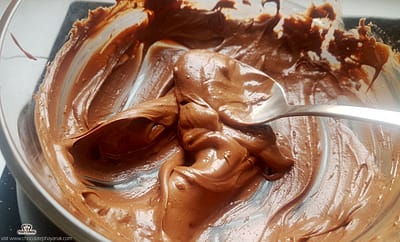Can overheated chocolate be saved?

Melting chocolate would seem like an easy thing to do, but you may find that sometimes it doesn’t always go to plan.
Chocolate can be very delicate and sometimes a lusciously smooth melted chocolate all of a sudden transforms into a thick and grainy mess. Why has this happened? It is probably because the chocolate has overheated.
As we saw in my other article, water can sometimes be chocolates worst enemy, as a small amount of moisture managing to find its way into chocolate will cause it to seize. But it is not just water that you have to worry about. Chocolate may also become stiff and dull if it has been overheated and or burnt.

Chocolate melts at a relatively low temperature and that is why it melts in your mouth. So it is easy to accidentally heat the chocolate too much.
Of course, this can be incredibly frustrating when it happens. But, if it does happen to you, fear not, as it may be possible to save your overheated chocolate.
Chocolate can be melted safely in a number of different ways, but if you overheat it, you will go from perfectly silky chocolate to something stiff and unappetising. Chocolate is very delicate and can overheat if you go above certain temperatures.

To prevent this from happening:
- Dark chocolate should never go above 120°F/48°C and milk and white chocolate above 110°F/43°C.
- Ensure that you use a decent thermometer when melting chocolate and keep track of the temperature regularly.
Check out the chocolate equipment page to see some recommended thermometers.

- When using a microwave, melt chocolate on medium heat and in short 10-15 second bursts. Take out the chocolate each time and stir it so it can melt evenly.
- Do not melt chocolate directly in a pan on the stove. Use a double boiler and ensure that the water doesn’t come to a boil. You might cook it too quickly and water may splash or steam into the bowl.
- Use heatproof bowls to prevent the chocolate from continuing to cook once melted.
- Chop your chocolate into small, uniform pieces so it can melt quickly and more evenly. Using a serrated knife and plastic cutting board, place your hand on the blunt side of the knife and finely chop the chocolate from the corner of the bar. If you are melting chocolate chips then don’t worry.
- Make sure no water or moisture enters the chocolate. It will cause it to seize and become stiff, gritty and difficult to stir. Read how to save seized chocolate?
How to save overheated chocolate
If you do find yourself overheating your chocolate, all is not lost.
Overheated or seized chocolate can sometimes be salvaged, or at least put to use in other kitchen recipes.
As long as it is not yet burnt, there are a few ways you can save your chocolate.
Take it off the heat and cool it straight away
Chocolate that is overheated needs to be cooled quickly to save as much as possible. Transfer the chocolate to a cool bowl and place it under a fan or air conditioner. If you leave the chocolate in the same bowl it will continue cooking from the heat of the bowl.

Add in chunks of chocolate

Chuck in a handful of chocolate buttons or chopped pieces of chocolate and stir until it melts. It will help to quickly bring down the temperature.
Alternatively, take the overheated chocolate off the stove and place it on an ice bath to rapidly cool it down. Be careful not to splash any water into the chocolate or it might seize.
Strain it through a sieve
If it is thick and clumpy, pour the chocolate through a sieve and hopefully be left with some unaffected melted chocolate.
Add some extra fat
If the chocolate remains stiff, try adding melted cocoa butter, a tablespoon at a time, and stir until it smoothens out and incorporates fully. You can use alternatives such as vegetable or coconut oil if you like.

Immersion Blender
If you just can’t seem to get it smooth again, you can just pull out an immersion blender to blend it smooth. An immersion blender is a handheld blender that you can just place straight into a bowl or container.
You can try adding a few drops of Soy Lecithin (an emulsifier) to bring down the viscosity of your chocolate and to help it become fluid again.
If all else fails
Save the chocolate for other baking recipes and start melting a fresh batch of chocolate.



Leave A Comment